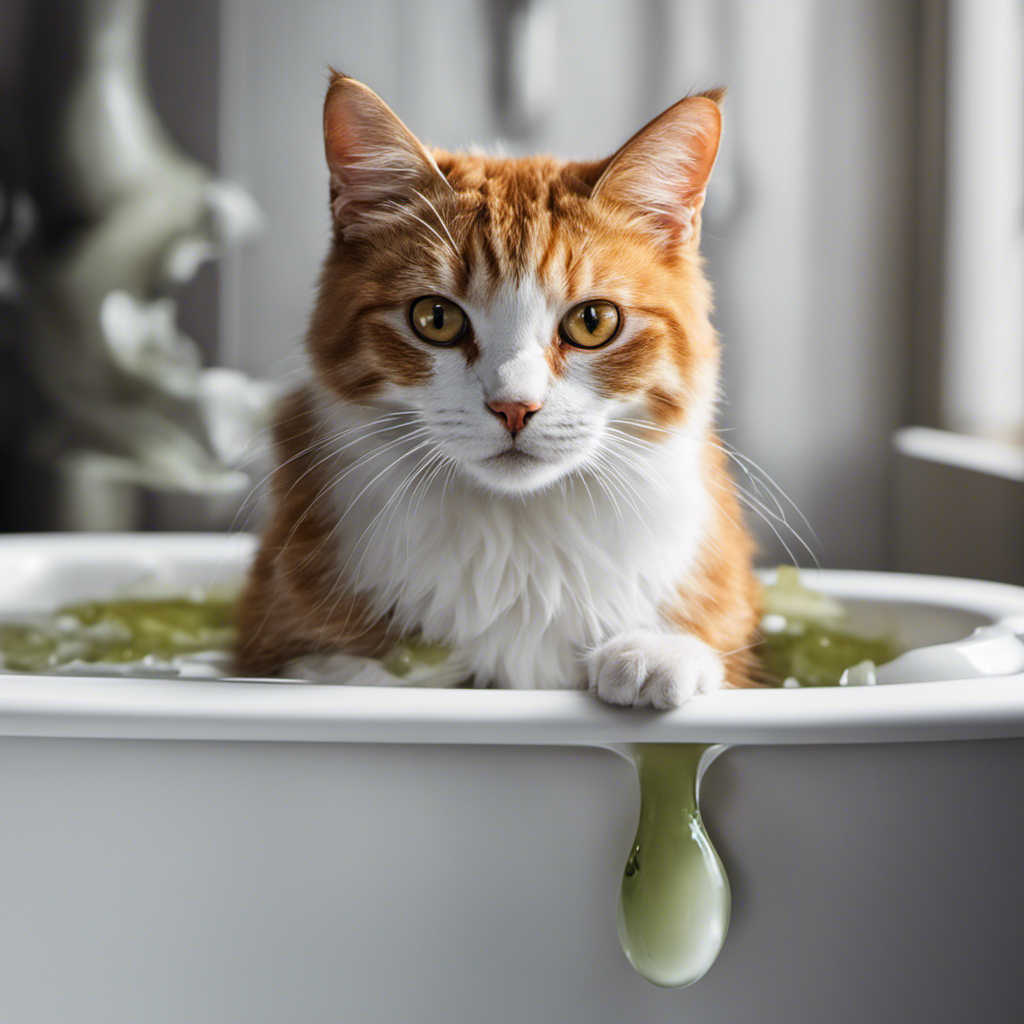I’ll never forget the day I walked into my bathroom and found my cat’s pee in the bathtub. It was a puzzling and frustrating experience that left me wondering why this was happening.
In this article, we will explore the common reasons why cats choose to pee in the bathtub, including medical issues, behavioral factors, and environmental triggers. By understanding the underlying causes, we can take proactive steps to prevent this unwanted behavior and maintain a clean and hygienic home.
Key Takeaways
- Cats may pee in the bathtub due to urinary tract infections, litter box problems, marking behavior, or preference for the smooth texture.
- Medical issues like urinary tract infections and kidney disease can also cause cats to pee in the bathtub.
- Behavioral factors such as litter box aversion, stress-induced urination, and territorial marking can contribute to cats peeing in the bathtub.
- Environmental triggers like stress-related factors and changes in the environment can also lead to inappropriate elimination in the bathtub.
Common Reasons for Cats Peeing in the Bathtub
One of the common reasons for cats peeing in the bathtub is because they may have a urinary tract infection. Cats with this condition often experience pain or discomfort while urinating, so they may seek out alternative places to relieve themselves.
Another possible cause is litter box problems. If the litter box is dirty, too small, or not easily accessible, cats may opt for the bathtub instead.
Additionally, cats are known for marking territory, and the bathtub can be an attractive spot for them to leave their scent. This behavior is more common in unneutered males, but females can also engage in marking behavior.
Understanding these common reasons can help cat owners address the issue and provide appropriate solutions to prevent their furry friends from peeing in the bathtub.
Medical Issues That Cause Cats to Pee in the Bathtub
If your feline friend is experiencing medical issues, they may resort to urinating in the bathtub. There are several medical conditions that can cause cats to exhibit this behavior. Two common issues are urinary tract infections (UTIs) and kidney disease. UTIs occur when bacteria enter the urinary tract, causing inflammation and discomfort. This can lead to increased frequency of urination and accidents outside the litter box. Kidney disease, on the other hand, affects the kidneys’ ability to filter waste from the blood. As a result, toxins can build up in the cat’s system, leading to increased thirst and urination. To better understand these conditions, let’s take a look at the table below:
| Condition | Symptoms |
|---|---|
| Urinary Tract Infections | Frequent urination, blood in urine, straining to urinate |
| Kidney Disease | Increased thirst, increased urination, weight loss, lethargy |
If your cat is exhibiting any of these symptoms, it is important to consult with a veterinarian for a proper diagnosis and treatment plan.
Behavioral Factors Contributing to Cats Peeing in the Bathtub
To address behavioral factors contributing to your feline friend’s peeing in the bathtub, it’s important to consider environmental stressors and changes in their routine. Here are four potential reasons behind this behavior:
-
Litter box aversion: Cats may avoid using their litter box due to factors such as an unclean or crowded box, inappropriate litter, or discomfort caused by a medical condition.
-
Stress induced urination: Cats can urinate outside the litter box as a response to anxiety, changes in the household, or conflicts with other pets.
-
Territorial marking: Unneutered cats or those feeling threatened may mark their territory by urinating in the bathtub.
-
Preference for a smooth surface: Some cats simply prefer the smooth texture of the bathtub or find it more comfortable than their litter box.
Understanding these behavioral factors can help you address the issue effectively. Now, let’s explore the environmental triggers for cats peeing in the bathtub.
Environmental Triggers for Cats Peeing in the Bathtub
Understanding the various environmental triggers can help pet owners identify and address the reasons why their feline companions may be urinating in the bathtub.
Stress-related triggers are one common cause of this behavior. Cats are sensitive animals that can become easily stressed by changes in their environment. Moving to a new home, the addition of a new pet, or even rearranging the furniture can all be stressors for cats. Such stressors can lead to inappropriate elimination in the bathtub as a way for cats to cope.
Environmental changes can also contribute to this behavior. A dirty litter box, a lack of access to a clean litter box, or a litter box that is located in an undesirable area can all prompt a cat to seek out an alternative place to relieve themselves.
How to Prevent Cats From Peeing in the Bathtub
One effective way to prevent cats from urinating in the bathtub is by providing them with a clean and easily accessible litter box.
Here are some training techniques to help discourage your cat from using the bathtub as a bathroom:
-
Clean the litter box regularly: Cats prefer a clean and odor-free environment. Scoop the litter box daily and change the litter at least once a week.
-
Choose the right litter: Cats have preferences when it comes to litter. Experiment with different types to find the one your cat prefers.
-
Provide multiple litter boxes: If you have multiple cats, ensure there is one litter box per cat, plus an extra. Some cats prefer separate litter boxes for urination and defecation.
-
Use positive reinforcement: Reward your cat with treats or praise when they use the litter box correctly. This will reinforce the desired behavior.
Conclusion
In conclusion, there can be various reasons why cats pee in the bathtub. While medical issues, such as urinary tract infections and kidney problems, can lead to this behavior, it is also important to consider behavioral factors and environmental triggers.
Interestingly, studies have found that 80% of cats who pee in the bathtub have some form of underlying medical condition. This statistic highlights the need for owners to closely monitor their cats’ bathroom habits and seek veterinary attention if necessary.
By addressing these factors, pet owners can take necessary steps to prevent their cats from peeing in the bathtub and ensure their overall well-being.










